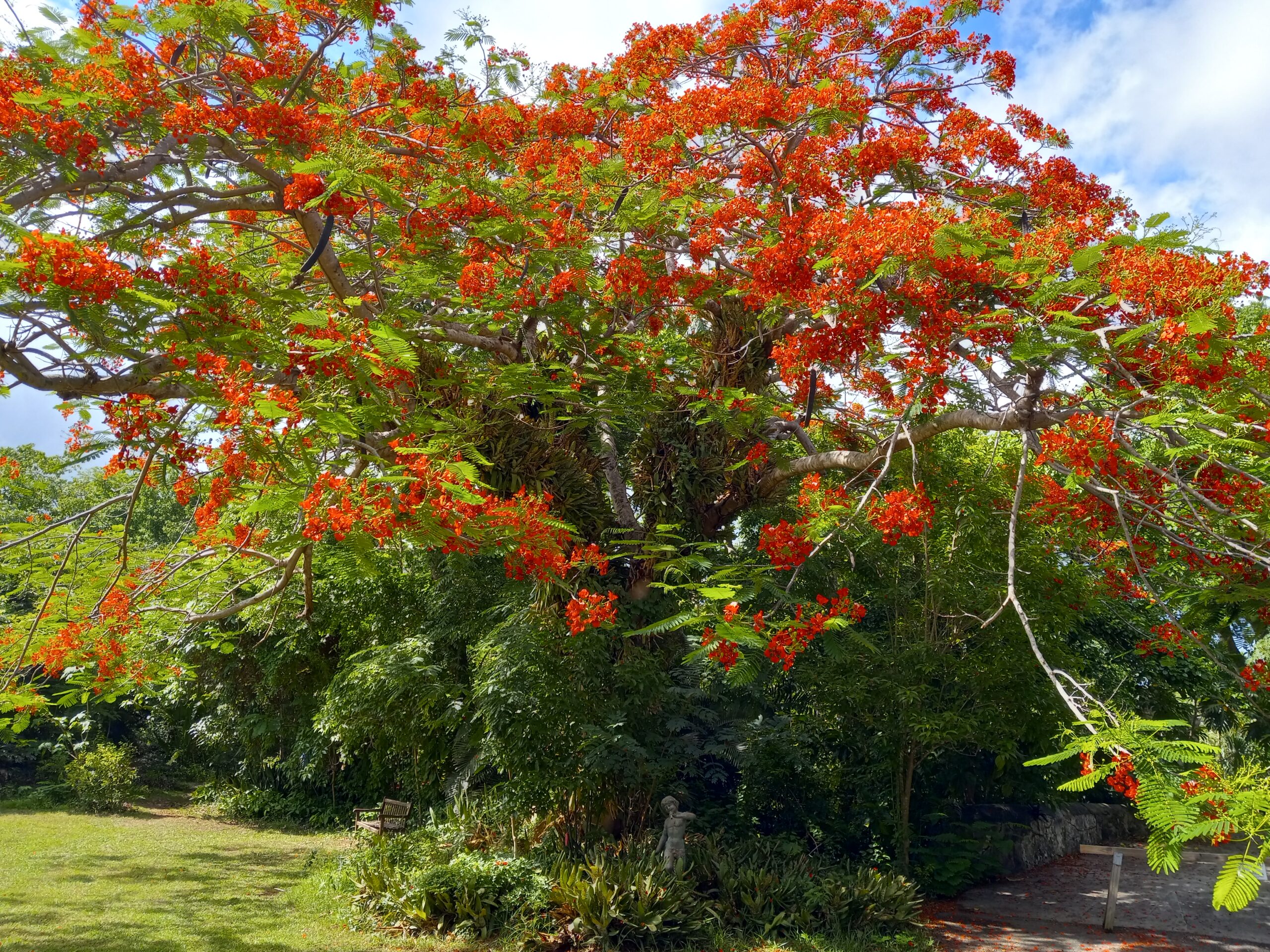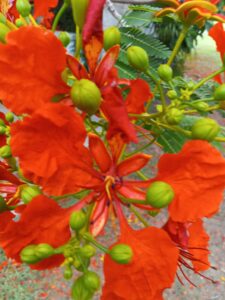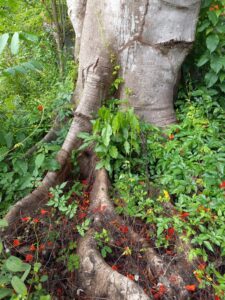
I cannot help but admire the beautiful blossoms of the Flamboyant trees, whether in people’s yards, along the roadsides, highways, or in forest settings. If we are sad or depressed for whatever reason, believe me, the brilliant masses of large red or orange flowers of the Flamboyant tree (Delonix regia) will bring smiles to our faces, despite the challenges we encounter in life. Nature is a medicine and it is free to all of us.

The Flamboyant tree is native to Madagascar, an island off the east coast of Africa. The trees were recorded as common in the West Indies in the 1880s. I believe in the 1940s somewhere about or probably earlier, an airplane flew over St. Thomas and scattered Flamboyant seeds all over the island. Trees that are flowering today on St. Thomas may be the offspring of the parent trees seeded in the 1940s.
Nevertheless, the Flamboyant is a small- to medium-sized deciduous tree becoming about 20 to 50 feet in height and two feet in trunk diameter, with a large sometimes buttressed base that angles toward the ground. The bark of the Flamboyant tree is grayish-brown and rather smooth, and it is sometimes slightly cracked with many lenticels. The tree develops a flat, wide-spreading crown — sometimes wider than it is high. Its leaves are compound. Each leaf is between one and two feet long, and then divided into numerous leaflets, the effect being a feathery and fern-like shape.
There are several flower clusters on the Flamboyant tree that are 6 to 10 inches long and are borne laterally near the end of a twig, each with loosely arranged, slightly fragrant flowers. If you noticed, the pods on the Flamboyant tree look like a large pea. It is because the Flamboyant tree is in the Leguminosae family, which means there are plants like peas, beans, tamarind, saman, etc., in that family. Remember, plants are organisms like humans. Therefore, plants are made up of different classifications as are we Homo sapien species.
The pods on Flamboyant trees are hard. They are 14 to 20 inches long, and 2 to 2 ¼ inches wide, and ¼ inch thick, finally splitting into two parts. The tree has several common names such as Royal Poinciana, Flamboyant, Flame Tree, etc. However, to identify trees, it is best to use the scientific names if possible. It eliminates the confusion of so many different trees with the same common names. Oftentimes, common names are from folklore, cultural, or based on the plant’s physical characteristics such as its form, color, etc., and not necessarily scientific.
In the 1740s, the word “Flamboyant” in the Danish West Indies referred to a wood called Flamboyant. Also, there is another word, “flamboy,” which referred to something different. “Once a goodly tract of forest (i.e., 400, 500, 600 feet square) has been cut back in this way and the wood has been lying eight to fourteen days drying, it is all set afire by six to seven slaves who walk about with a kind of wood, there called ‘flamboyant’, which, once ignited, produces a large flame,” noted Reimert Haagensen, a Danish planter who lived on St. Croix during the 1740s and 1750s.
The term flamboy derives from flambeau, the French term for a torch. “Armed with a bright torch called flamboy slaves go down to the beach at night and, walking along with this torch, can pick the lobsters up with their hands,” noted Haagensen. Up to the 1960s, Flamboy was commonly used by fishermen on St. Croix to catch lobsters at night. The lobsters stay among the large rocks near the beach at night. This way of catching lobster was cultural in the Virgin Islands, but it no longer exists.

The time of Flamboyant flowering varies in the Caribbean, where it is the national flower of St. Kitts and Nevis. In Barbados, the tree blossoms between June to August. In Jamaica, it blossoms from May to July, and in Trinidad it can be seen in flower in April. In the Virgin Islands, the flower of the Flamboyant tree appears from June to November. However, there is a tradition with the Flamboyant in relationship to hurricane season in the Virgin Islands. I believe, if I am not mistaken, that if the Flamboyant tree starts to blossom before hurricane season we might not be hit with a storm. However, if the trees start to blossom from June and end in November, there is that possibility of a hurricane coming our way.
We are in the month of August. Therefore, the prediction is that hurricanes will become more frequent in the Caribbean region. As we can see, the flowers of the Flamboyant trees are dark red and bright orange. This is due to a perfect storm — not necessarily a hurricane, but rain. We are still in a drought, although the islands are green. When the streams and guts start to run for days, weeks, and months, then we are getting rain like the old folks would say, “water more than flour.” In other words, we got so much more rain than we asked for.
Again, the old people lived close to nature. I quote from one of the late George A. Seaman’s notes of wisdom: “It is still raining and if September and October have been good months, then many little guts would have come to life.” It is also believed by some cultures that the blood of Jesus Christ was shed over the flowers of the tree and that is how the flowers got a sharp red color. On our sister island of Puerto Rico, the Flamboyant symbolizes pride, hope, and rest.

And finally, the pods are used as cultural instruments whereas the tree has medicinal use, and you should never plant a flamboyant tree close to your house. Its wide-spreading root system can be a threat to your house, building foundations, sidewalks, or any other manmade structures. If you have hundreds of worms on your Flamboyant tree, call my colleague the Bug Doctor at the School of Agriculture, University of the Virgin Islands, Amy Dreves at 340-692-4052. On the bright side of things, the worms won’t kill your Flamboyant tree. They are symbiotic. In other words, in nature, species will sometimes form unexpected relationships that work to their mutual benefit.
— Olasee Davis is a bush professor who lectures and writes about the culture, history, ecology and environment of the Virgin Islands when he is not leading hiking tours of the wild places and spaces of St. Croix and beyond.





